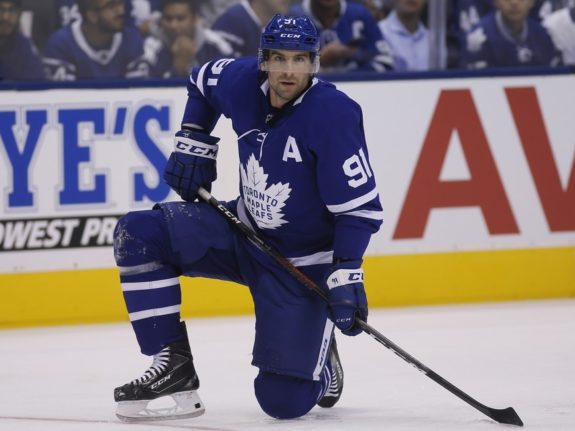![]()
The playoff-type feel at Scotiabank Arena this past Saturday was not as premature as one might think, given that three months remain until the Stanley Cup tournament. The Boston Bruins concluded their season series against the Toronto Maple Leafs with a thrilling 3-2 victory, their third win in four meetings. If the postseason began today, the two teams, currently separated by a single point in the standings, would again meet in the Eastern Conference Quarterfinals.
As you might recall, the longtime rivals matched up in the opening round of the postseason last April, a classic seven-game series, won by the Bruins. The outcome had a direct correlation to the summer’s biggest splash in free agency, the Leafs’ signing of center John Tavares to a seven-year, $77 million mega-deal. Toronto was immediately catapulted into the Cup Contenders category, ahead of their Atlantic Division brethren in Boston.

Six months and four games later, the Bruins (and their fans) need not worry about a potential rematch come the Spring. In taking the season series three games to one, the Black and Gold proved that with unforeseen intangibles aside (i.e. injuries, suspensions, trades), they are still the better team.
Here’s how the Bruins and Leafs stack up to date.
Bruins Built Better From Back End Out
If the belief that the best hockey teams are those built from the back end out, then the Bruins figure to have a decisive advantage. While Bruins goaltender Tuukka Rask has yet to establish himself as a trusted playoff performer (35-30 record, 2.25 goals-against average, .924 save percentage), his numbers and seniority, not to mention his recent resurgence, give him an edge over counterpart, Frederik Andersen.
Even amid a career year (20-9-1 record, 2.50 GAA, .923 SV%), Andersen’s postseason performances, particularly last season’s, will fail to instill any fear into the opposition. The Bruins lit him up for 24 goals, including three on just eight shots in Game 2 before he was pulled midway through the opening period. In a do-or-die Game 7, he surrendered six more tallies, ballooning his career postseason GAA to a forgettable 2.61.

For the sake of fairness, let’s not forget that in many, if not most cases, a goaltender is only as good as the defensive corps in front of him. If anything was apparent on Saturday, it was that the Leafs blueline needs plenty of work despite featuring a Norris Trophy candidate in Morgan Rielly. Toronto ranks 14th in shots on goal allowed per game (SA/GP; 32.23). In comparison, Boston’s 31.18 SA/GP ranks them 17th. With the recent returns of Zdeno Chara, Charlie McAvoy, and Kevan Miller, the Bruins blueline is fully healthy with eight viable options.
Bruins ‘Perfection Line’ has Proven Unstoppable
With the emergence of Mitch Marner, there is no doubting that the Leafs boast a trio capable of challenging the scoring pace of the Bruins ‘Perfection Line’ featuring Patrice Bergeron, Brad Marchand, and David Pastrnak. However, by virtue of positioning, Marner, and Tavares skate on the top line while Auston Matthews centers the second unit.
Much like they did in the opening round last season, Boston’s top three had its way with Toronto in 2018-19. Pastrnak led the way with six goals, three assists, and a plus-five while Marchand collected seven assists and a plus-three. In two games, Bergeron added a goal, two assists, and a plus-three. The collective 19 points and plus-11 rendered the Leafs’ big three’s production moot, as Marner (one goal, four assists), Tavares (one goal, one assist) and Matthews (one goal, two assists in two games) combined to finish minus-five. Even with better depth scoring from the Leafs, the Bruins structured defensive style, coupled with their top line’s ability to take over any game at any given time figures to give them the inside track at advancing.

I would, of course, be remiss without mentioning that the Bruins have recent history, beyond last year, on their side, having prevailed in the last four postseason series, dating back to 1968-69. The pinnacle came in 2013 when the Bruins completed the greatest comeback in franchise history, erasing a 4-1 deficit in the third period of Game 7 before Bergeron’s overtime goal broke hearts all over Leafs Nation. Five years later, the Bruins needed as many games to advance. Expect more of the same should they meet again this Spring.